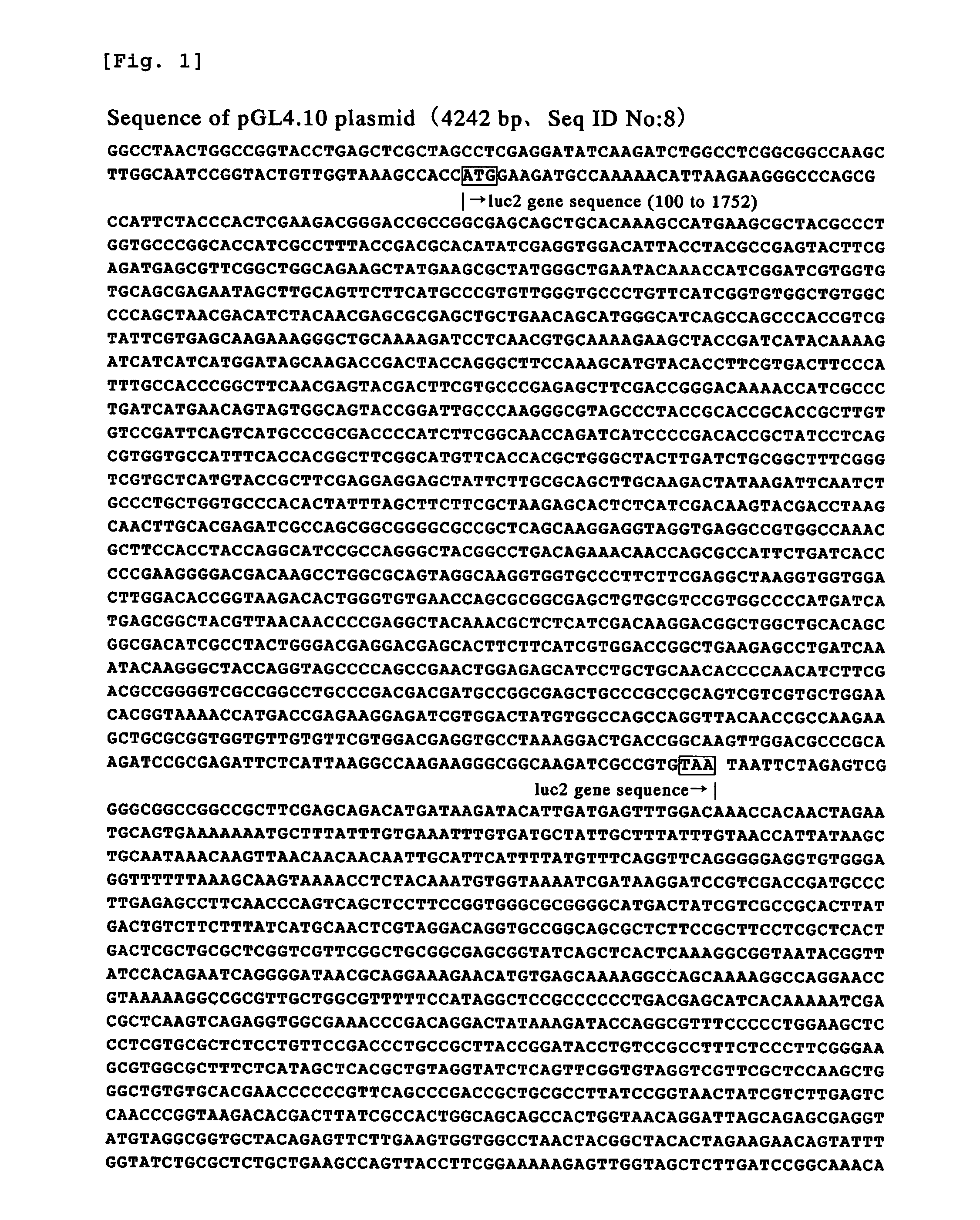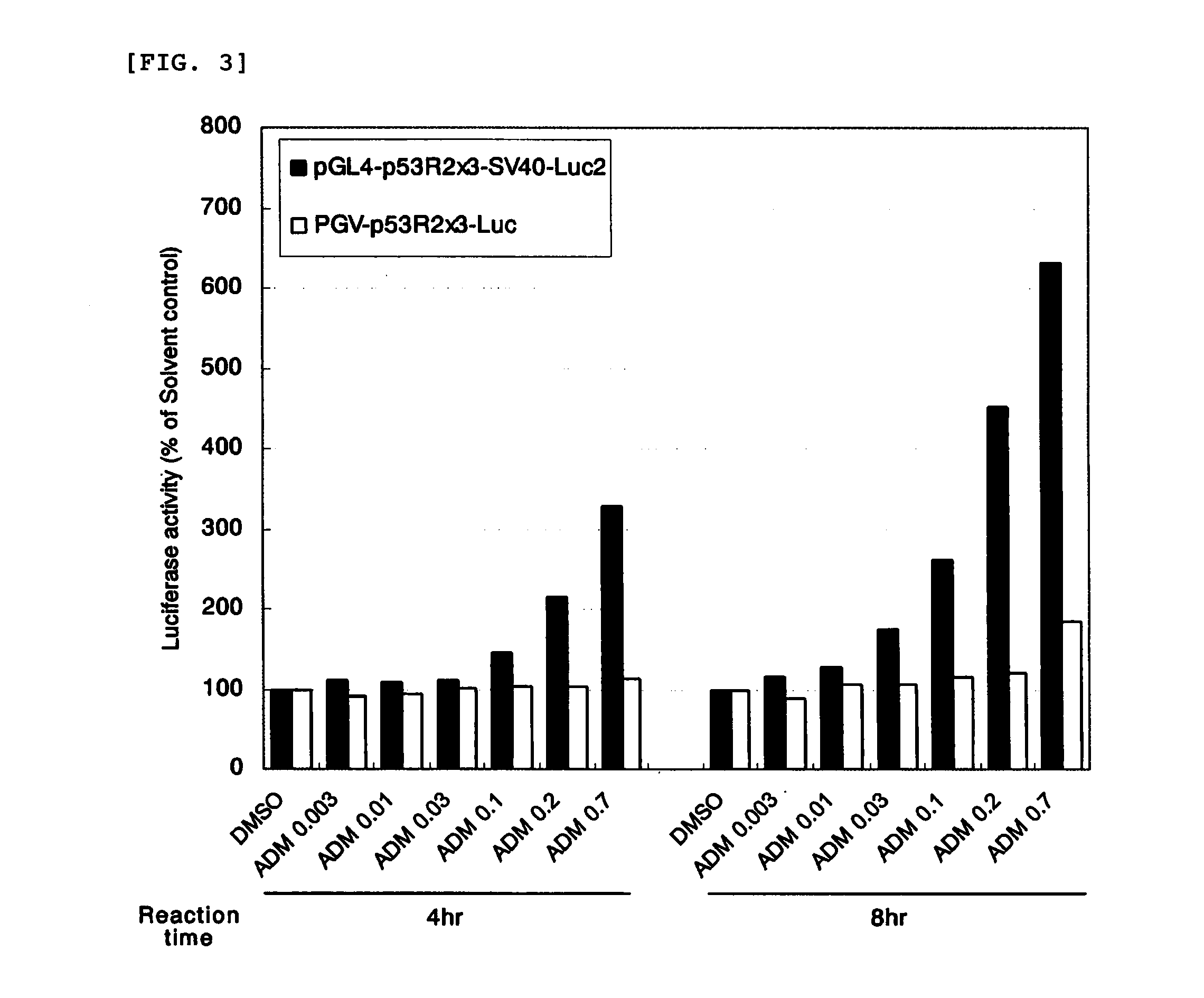Mutagenicity test method using mammalian cells
- Summary
- Abstract
- Description
- Claims
- Application Information
AI Technical Summary
Benefits of technology
Problems solved by technology
Method used
Image
Examples
example 1
Production of Recombinant Vector
[0123]An oligonucleotide formed of a base sequence including three repeats of a p53 binding sequence of p53R2 gene intron to be expressed by DNA damage (5′-CTGACATGCCCAGGCATGTCTTGACATGCCCAGGCATGTCTTGACATGCCCAGGCATG TCTA-3′: SEQ ID NO: 10), and an oligonucleotide formed of a base sequence complementary to this base sequence (5′-GATCTAGACATGCCTGGGCATGTCAAGACATGCCTGGGCATGTCAAGACATGCCTGGG CATGTCAGGTAC-3′: SEQ ID NO: 11) were each synthesized with a DNA synthesizer, and the oligonucleotides were annealed to form double-stranded DNA.
[0124]A plasmid pGL4.10 including a firefly luciferase gene (manufactured by Promega) was digested with restriction enzymes KpnI and BglII and then subjected to electrophoresis using low melting point agarose (NuSieve 3:1 Agarose; manufactured by BMA), and 4,214-bp DNA of interest was collected from a gel at a band portion. About 30 ng of the DNA and 1 ng of the DNA including three repeats of the p53 binding sequence were mixed ...
example 2
Production of Recombinant Vector; Repertoire of Promoter; Preparation of Reporter Plasmid Including SV40 Minimal Promoter
[0125]A plasmid PGV-p53R2×3-Luc prepared by the method described in Example 1 of JP 4243716 B2 was digested with restriction enzymes BglII and HindIII and then subjected to electrophoresis using low melting point agarose (NuSieve 3:1 Agarose; manufactured by BMA), and 198-bp DNA of interest was collected from a gel at a band portion and named an SV40 minimal promoter (5′-TGCATCTCAATTAGTCAGCAACCATAGTCCCGCCCCTAACTCCGCCCATCCCGCCCCT AACTCCGCCCAGTTCCGCCCATTCTCCGCCCCATCGCTGACTAATTTTTTTTATTTATGCAG AGGCCGAGGCCGCCTCGGCCTCTGAGCTATTCCAGAAGTAGTGAGGAGGCTTTTTTGGAGGC CTAGGCTTTTGCAAAA-3′: SEQ ID NO:13).
[0126]The reporter plasmid pGL4-p53R2×3-Luc2 prepared in Example 1 was digested with restriction enzymes BglII and HindIII and then subjected to electrophoresis using low melting point agarose, and 4,257-bp DNA of interest was collected from a gel at a band portion. About 3 ng of t...
example 3
Production of Recombinant Vector; Repertoire of Promoter; Preparation of Reporter Plasmid Including Tk Minimal Promoter
[0127]A plasmid PGV-p53R2×3-tk-Luc prepared by the method described in Example 3 of JP 4243716 B2 was digested with restriction enzymes BglII and HindIII and then subjected to electrophoresis using low melting point agarose (NuSieve 3:1 Agarose; manufactured by BMA), and 181-bp DNA of interest was collected from a gel at a band portion and named a tk minimal promoter (5′-TAAGAAAATATATTTGCATGTCTTTAGTTCTATGATGACACAAACCCCGCCCAGCGTC TTGTCATTGGCGAATTCGAACACGCAGATGCAGTCGGGGCGGCGCGGTCCCAGGTCCACTTC GCATATTAAGGTGACGCGTGTGGCCTCGAACACCGAGCGACCCTGCAGCGACCCGCTTAAA-3′: SEQ ID NO: 14).
[0128]The reporter plasmid pGL4-p53R2×3-Luc2 prepared in Example 1 was digested with restriction enzymes BglII and HindIII and then subjected to electrophoresis using low melting point agarose, and 4,257-bp DNA of interest was collected from a gel at a band portion. About 3 ng of the DNA and 10 ng of...
PUM
| Property | Measurement | Unit |
|---|---|---|
| Time | aaaaa | aaaaa |
| Fraction | aaaaa | aaaaa |
Abstract
Description
Claims
Application Information
 Login to View More
Login to View More - R&D
- Intellectual Property
- Life Sciences
- Materials
- Tech Scout
- Unparalleled Data Quality
- Higher Quality Content
- 60% Fewer Hallucinations
Browse by: Latest US Patents, China's latest patents, Technical Efficacy Thesaurus, Application Domain, Technology Topic, Popular Technical Reports.
© 2025 PatSnap. All rights reserved.Legal|Privacy policy|Modern Slavery Act Transparency Statement|Sitemap|About US| Contact US: help@patsnap.com



